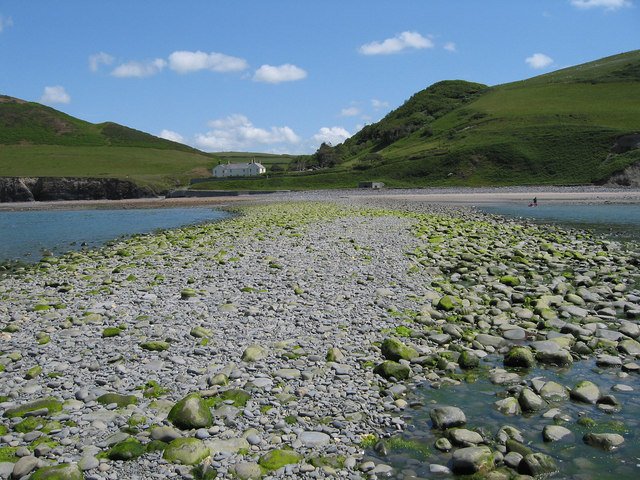The Undrowned Goddess

Part of the submerged forest near Borth
For much of early January it rained constantly here in Bala and there were flood alerts around the Upper Dee area. I’ve lived here long enough now to realise that Wales, perhaps even more than the rest of the British archipelago, experiences a constant negotiation between land and water, and that nearly half the annual precipitation falls between Samhain and Imbolc. We’re close to Atlantic weather systems and of course much of the land is over 150 metres; Snowdonia is, after all, the wettest part of Wales.
And in a time of uncertainty and climate change there is clearly concern: Natural Resources Wales is halfway through a major project to ensure Llyn Tegid, Bala Lake, can continue to withstand extreme weather, strengthening embankments, replacing stone protection and, very sadly, removing a couple of hundred trees, mostly ash, which are said to have weakened the embankments. The British climate is almost 10% wetter now than in the years from 1961 to 1990 and is likely to become more so, although we’re not likely to see all changes in weather patterns clearly until at least the 2040s.[1]
Not all inundations can be blamed directly on the weather and a little further south tales have been told for centuries of an entire flooded kingdom, gaining a greater audience since a storm in 2019 pounded the shores of Borth and Ynyslas in Ceredigion, uncovering the remains of trees – pine, alder, oak and birch – that had been buried for thousands of years.[2] Evidence perhaps of the lost lands known as Cantre’r Gwaelod or “Lowland Hundred”, governed by Gwyddno Garanhir[3], born around 520 CE, from his palace, Caer Wyddno, near Aberystwyth. It’s claimed that the land stretched some 20 miles out into what is now Cardigan Bay.[4] A sophisticated system of sea walls and gates kept the land, which was below sea level, safe, while water was allowed in to irrigate the fields and pastures, for an acre of land here was worth any four elsewhere. In many versions of the tale the job of closing the sea gates fell to the watchman, Seithenyn, but after enjoying himself at a feast rather too much he forgot one night and so the land was drowned. This is very like the story of how Llyn Tegid, Bala Lake, was created.[5]

Sarn Gynfelin[6]
The king and some of his court escaped the flooding by running along Sarn Cynfelin, one of several ridges running more or less right-angled to the shore, according to an article in Herald Wales,[7] which tells us each ridge is several miles long. Legend says these are the remains of causeways, but they are more likely those of glacial moraines – piles of gravel, sand, clay and boulders left when the glaciers melted.
Archaeologists have also found a timber walkway in the area, dated between 3,000 and 4,000 years ago, and both human and animal footprints were discovered preserved in the top layer of peat, along with burnt stones, suggesting ancient hearths.[8] It’s likely that the initial flooding took place around 8,000 to 10,000 years ago, when sea levels rose dramatically at the end of the Ice Age.[9]
Perhaps, then, the tales are much older, a folk memory of the rising sea and lost lands from that distant past, told orally for centuries, if not millennia. It’s easy to imagine how much the stories would have changed over such an immense period of time. Not to mention that when first written down around the High Middle Ages much of Christian thought was interpolated, together with its patriarchal baggage.
There are inundation myths from all over the world and some people like to call Cantre’r Gwaelod “The Welsh Atlantis”. But most strikingly similar are the tales of Kêr-Ys, off the coast of Brittany, and of Lough Neagh, in Ireland. Kêr-Ys has much in common with the Welsh tale (the Breton name means something like “low city”); it had been reclaimed from the sea, again with sophisticated dikes and a gate that could be opened at low tide to allow in ships. The king, Gradlon, is said to have converted to Christianity but his daughter, Dahut-Ahes, kept to Pagan ways. In some variations of the tale, Dahut’s mother, Malgven, was a goddess of the Tuatha Dé Danann, the people forced underground to live as faeries by the new, patriarchal religion. Perhaps because of this lineage, and pained by the greed, violence and power hunger of the men who came to court her, writes Judith Shaw, the young woman sent them all away and decided that a fresh start was needed. Dahut stole the key to the gate from her father and called on the Goddess and the waters to drown the city. Her father tried to save her but the Christian priest, Guénolé, persuaded him to let his daughter drown, but of course Dahut lives on below the waves in the sunken city, together with those of her people who followed the Old Ways.[10]

Flight of King Gradlon, by Evariste Vital Luminais[11]
As so often with such ancient stories, that of the creation of Lough Neagh among them, there are many different versions, but a typical tale goes that Lí Ban, the daughter of one King Eochaid, one night forgot to cover the well, which overflowed to create the huge lake. Her father was drowned but Lí Ban, who had been a mermaid all along, survived and roamed the sea for hundreds of years until her beautiful singing voice led to her discovery by St Comgall, who baptised her as Muirgen – our equivalent name would be Morgan.
Life originated in water. We know this today from the work of scientists, but it’s also something we’ve always intuitively been aware of, perhaps because we all spend months in the inland sea of our mothers’ wombs. It is certainly noticeable that in many of these stories of inundation a woman is Guardian of the Waters, perhaps recalling a time when this was the case; when seas and oceans were personified by Her, when no traveller would suffer hunger or thirst beause every well had an associated maiden who would appear on request with food and drink, served alongside a beautiful, golden cup. Until, that is, one of the maidens was raped and robbed by a wicked king and then and emulated by his vassals, until the maidens were no longer at the springs or wells and the land itself sickened.
In Women of the Celts, Jean Markale tells us of Ilmatar, the Mother of the Waters in the Kalevala, the epic Finnish creation myth. After many centuries swimming in the oceans she birthed the first human being, recalling, perhaps, both the birth of Aphrodite from sea foam and also of Muirgen (Morgan), a name which probably means “born of the sea”.[12] And the sea, like woman, has mystery, depth and forbidden aspects, not to mention danger. Indeed, Markale believed that for the Celts the basic myth of creation involved submerged lands.[13]
Legends of mermaids abound, and just as fishermen close to the drowned Kêr-Ys insist that they have seen Dahud swimming among shoals of fish, Lí Ban is clearly a mermaid from the start of her tale. It seems a pity that our tales of Cantre’r Gwaelod are brief compared to others but the different versions include one that suggests Seithenyn was a visiting king who tried to seduce Gwyddno’s daughter, Mererid, and by doing so prevented her from attending to her task of keeping the gates closed. A poem in the Black Book of Carmarthen reads as though Mererid is entirely to blame:
“Cursed be the maiden
Who let it loose after the feast,
The cup-bearer of the mighty sea.”[14]
Blaming women for attracting men isn’t something that only happened in the past, of course. Ask any rape survivor whether she was asked what she was wearing, and whether she did anything to attract her attacker’s attentions. Like existing, for example?
Herald Wales also tells us that an earlier legend of Cantre’r Gwaelod involved the land being drowned when the priestess of a fairy well allowed the water to overflow, but we don’t know if this was indeed Mererid.[15] Given the similarity of the Kêr-Ys story and the mention of the fairy well priestess it seems very possible that Mererid, too, did live to tell the tale and in a short and well-produced video on the Celtic Routes website we can hear yet another variation on the story and see the submerged forest.[16]
Although the Kêr-Ys story does contain much Christian material, Markale[17] notes some fascinating detail, writing that Dahud’s name comes from dago-soitis, meaning “good witch”, and that she is an ancient Breton goddess. She also, he notes, represents a rebellion against masculine authority, for example by stealing the key from her father.
Had all these women, these maidens in charge of keeping water and land separate, failed? You’d be forgiven for thinking so, and sometimes it seems they were damned whatever they did; even evading a would-be seducer leads to curses and blame. But still the tales persisted and still the waters needed guardians; stories of mermaids, maidens of springs and wells and goddesses of the oceans and seas persist to this day.
The balance between water and land has not been so delicately poised for a very long time, perhaps these stories might help us be mindful of the problems we’ve caused ourselves and to look for solutions, not only by activism and changing our ways but also on the level of spirituality and our relationships with goddesses of both land and sea. The undrowned, the Guardians of the Waters, are still with us.
Geraldine Charles
January 2023
[1] Met Office, “UK and Global Extreme Events – Heavy Rainfall and Floods,” Met Office (Met Office, November 2021), https://www.metoffice.gov.uk/research/climate/understanding-climate/uk-and-global-extreme-events-heavy-rainfall-and-floods. Accessed 24/1/23
[2] Chris Griffiths, “How a Storm Revealed a Welsh Kingdom,” Bbc.com 2021, https://www.bbc.com/travel/article/20200318-how-a-storm-revealed-a-welsh-kingdom. Accessed 10/1/23
[3] An interesting aside is that Gwyddno’s son Elffin was the fisherman who caught not a salmon but a baby boy inside a leather bag, whom he named Taliesien. See https://ceridwencentre.co.uk/the-story-of-ceridwen/ for details
[4] Given that the shortest distance between Wales and Ireland (the tip of Lleyn to Wicklow Head) is little more than 30 miles it’s interesting to consider how the giant, Bran, might almost have waded between the two if the distance were cut by 20 miles or so.
[5] Geraldine Charles, “Unpathed Waters, Undreamed Shores: Watery Tales from Llyn Tegid” The Goddess Temple of Bala, June 2021, https://goddesstemplebala.co.uk/2021/06/23/unpathed-waters-undreamed-shores-watery-tales-from-llyn-tegid-summer-solstice-2021/.
[6] By Dave Croker, CC BY-SA 2.0, https://commons.wikimedia.org/w/index.php?curid=13533316
[7] Doug.Evans, “The Lost Land of Cantre’r Gwaelod: The Welsh Atlantis? – Herald.Wales,” Herald.Wales, May 2021, https://www.herald.wales/uncategorised/the-lost-land-of-cantrer-gwaelod-the-welsh-atlantis/. Accessed 10/1/23
[8] “THE LOST KINGDOM of CANTRE’R GWAELOD,” Celtic Routes, 2014, https://celticroutes.info/celtic-highlights-old/the-lost-kingdom-of-cantre-r-gwaelod/. Accessed 10/1/23
[9] “Cantre’r Gwaelod – the Mythical Sunken Kingdom of Wales,” Ancient Origins Reconstructing the story of humanity’s past (Ancient Origins, May 2015), https://www.ancient-origins.net/myths-legends-europe/cantrer-gwaelod-mythical-sunken-kingdom-wales-003023.
[10] Judith Shaw, “Dahut, the Once and Future Goddess by Judith Shaw,” Feminismandreligion.com (WordPress.com, November 2015), https://feminismandreligion.com/2015/11/25/dahut-the-once-and-future-goddess-by-judith-shaw/. Accessed 15/1/23
[11] Flight of King Gradlon by Evariste Vital Luminais, Musée des Beaux-Arts de Rennes.JPG
[12] Jean Markale, “Women of the Celts” (Trans. A Myngind, C Hauch & P Henry), Inner Traditions, Vermont, 1986
[13] Ibid
[14] http://www.cantrer.pale.org/pages/poem/
[15] Doug.Evans, “The Lost Land of Cantre’r Gwaelod: The Welsh Atlantis? – Herald.Wales,” Herald.Wales, May 2021, https://www.herald.wales/uncategorised/the-lost-land-of-cantrer-gwaelod-the-welsh-atlantis/. Accessed 10/1/23
[16] “THE LOST KINGDOM of CANTRE’R GWAELOD,” Celtic Routes, 2014, https://celticroutes.info/celtic-highlights-old/the-lost-kingdom-of-cantre-r-gwaelod/. Accessed 10/1/23
[17] Jean Markale, “Women of the Celts” (Trans. A Myngind, C Hauch & P Henry), Inner Traditions, Vermont, 1986

